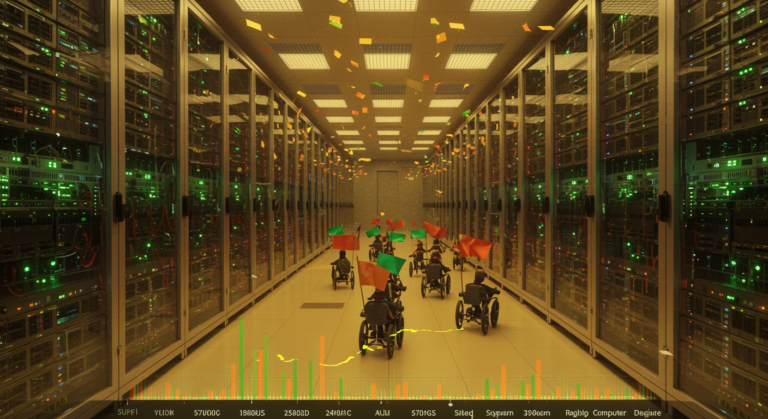
Exponential AI Growth: Implications for Task Handling and Usage
Understanding the Rapid Expansion of AI Capabilities
Have you ever wondered how exponential AI growth is transforming everyday tasks? Artificial Intelligence (AI) is no longer just a futuristic concept; it’s reshaping industries at an astonishing pace. This surge stems from our tendency to overlook how quickly innovations compound, a cognitive trap called exponential growth bias, as highlighted in a study from the University of Kansas.
Modern AI systems, from generative models to advanced automation tools, are evolving faster than we can fully grasp. For instance, imagine a simple algorithm that starts handling basic data analysis and, within months, tackles complex predictions— that’s the power of exponential AI growth in action. As capabilities double rapidly, AI is stepping into roles that were once exclusively human, influencing everything from healthcare diagnostics to creative design.
Researchers note that this acceleration isn’t just theoretical; it’s backed by real-world data showing AI’s ability to manage intricate processes with increasing efficiency. What does this mean for us? It opens doors to unprecedented productivity, but it also demands we adapt quickly to stay ahead.
The Nature of Exponential Growth in AI
Picture this: Just like Moore’s Law predicted computing power would double every couple of years, exponential AI growth is pushing boundaries in processing speed, data handling, and algorithm sophistication. This isn’t linear progress; it’s a compounding force that multiplies opportunities across sectors.
Industries are lowering barriers to AI adoption, making tools more accessible for businesses of all sizes. Yet, our intuition often fails to keep up—think about choosing between a fixed sum of money versus one that doubles daily; the latter explodes far beyond expectations, much like AI’s advancements.
Exploring the AI Task Competency Curve
One fascinating aspect of exponential AI growth is how AI models are becoming competent at handling tasks twice as complex every few months. According to recent studies, AI excels in short, knowledge-based activities, achieving near-perfect success for tasks under four minutes.
But flip that coin, and you’ll see limitations: For assignments exceeding four hours, success rates plummet to around 10%. How does this compare to humans? In many cases, we’re still superior in sustained, multi-step endeavors, but AI is closing the gap fast.
| Task Duration | AI Success Rate | Human Comparison |
|---|---|---|
| < 4 minutes | ~100% | Similar or higher |
| > 4 hours | ~10% | Generally higher |
This curve underscores AI’s strengths in quick, data-heavy tasks while highlighting areas for future improvement. As exponential AI growth continues, we might soon see AI managing those longer projects with ease—what could that mean for your daily workflow?
Implications for Task Handling and Exponential AI Growth
The ripple effects of exponential AI growth are revolutionizing task management and automation in profound ways. Routine work, once a drain on human resources, is now streamlined, allowing teams to focus on innovation.
For example, in project management, AI tools predict outcomes and optimize resources, cutting errors and boosting efficiency. Businesses are automating repetitive tasks, enhancing accuracy through vast data processing, and enabling round-the-clock operations that humans simply can’t match.
Transforming Content Creation and Knowledge Work
Ever tried writing an article from scratch? With exponential AI growth, tools can now generate SEO-optimized content in minutes, slashing production time for writers and marketers. This isn’t just about speed; it’s about scaling high-quality output while maintaining engagement.
Take a hypothetical scenario: A small business owner uses AI to customize blog posts for different audiences, ensuring relevance and consistency. However, remember that human oversight is crucial for fact-checking and infusing a unique voice—AI handles the heavy lifting, but we bring the soul.
Actionable tip: Start by integrating AI for research and drafting, then refine with your expertise to create content that resonates and ranks well.
Challenges and Sustainability Concerns in Exponential AI Growth
While the benefits are exciting, exponential AI growth isn’t without hurdles, particularly around energy use and environmental impact. Training advanced models can consume energy equivalent to 100 times that of a standard search, raising red flags for sustainability.
This creates a paradox: As AI drives efficiency, it also increases carbon footprints, conflicting with global decarbonization efforts. What if we shifted focus to greener energy sources? Experts suggest investing in efficient designs and regulations to balance progress with planetary health.
A relatable example: Imagine a company using AI for supply chain optimization but offsetting emissions through renewable energy—small steps like this could make a big difference.
Will Exponential AI Growth Continue Indefinitely?
Is exponential AI growth sustainable in the long run? Debates rage on, with some arguing that logistical limits, like data scarcity and hardware constraints, might slow this trajectory. Unlike unchecked expansion, real-world factors could lead to a more gradual progression.
Despite these concerns, optimism persists fueled by massive investments—projections show the AI market hitting $1.3 trillion by 2032. Think about it: If funding keeps pouring in, could we overcome these barriers and maintain this momentum?
Here’s some advice: Stay informed on emerging trends and diversify your skills to adapt, whether you’re in tech or another field.
Maximizing the Benefits of Exponential AI Growth
To truly leverage exponential AI growth, individuals and organizations need proactive strategies. Start by upskilling in AI-related areas, like learning to use predictive analytics for better decision-making.
Consider embracing automation for mundane or risky tasks, freeing up time for creative pursuits. Ethical adoption is key—focus on transparency and accountability to build trust.
One strategy: Regularly review AI tools in your workflow and adjust based on performance, ensuring they align with your goals.
Final Thoughts on Exponential AI Growth
In wrapping up, exponential AI growth promises a future of enhanced productivity and innovation, yet it demands we address ethical and environmental challenges head-on. By balancing optimism with caution, we can navigate this landscape effectively.
What are your thoughts on AI’s rapid rise? Share in the comments, explore more on our site, or connect with us to discuss how it’s impacting your work—let’s keep the conversation going!
References
- University of Kansas Study on Exponential Growth Bias. (2023). Source
- Live Science on AI Task Complexity. (2023). Source
- Effective Altruism Forum on AI Takeoff. (2023). Source
- The Science Dev on AI Computation Growth. (2023). Source
- Infosys on AI’s Exponential Growth. (2023). Source
- The AI Summit on AI Project Management Tools. (2023). Source
- Ry Rob on AI Article Writing. (2023). Source
- ML Science on Exponential Growth. (2023). Source
exponential AI growth, AI task handling, AI implications, automation in business, AI capabilities, exponential growth bias, AI automation, sustainable AI, AI in industries, predictive analytics







